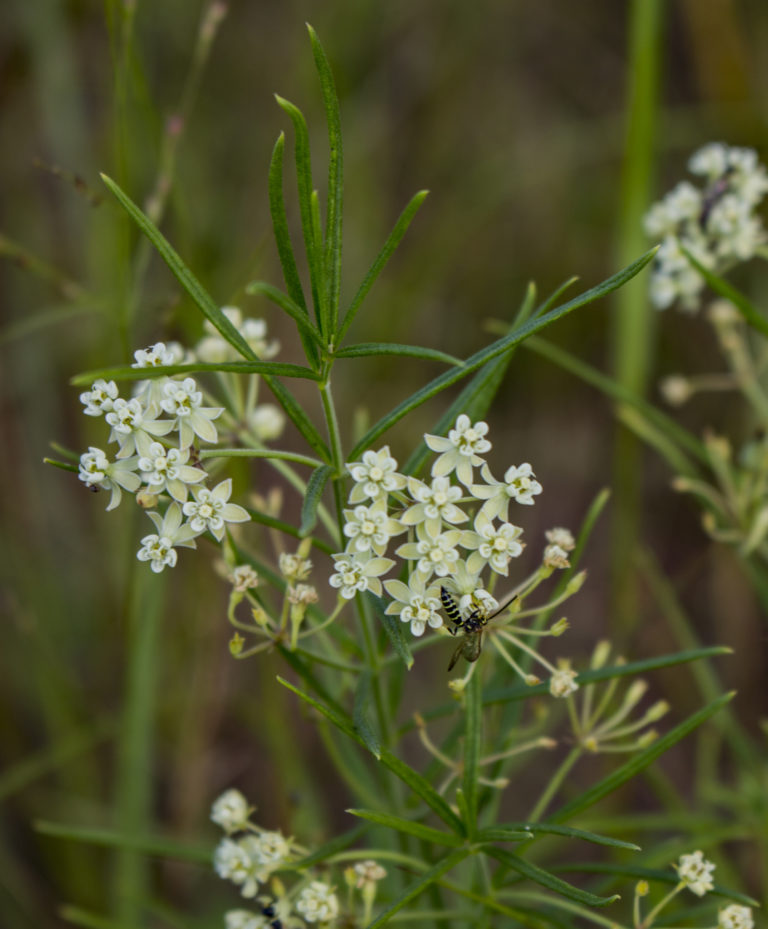Whorled Milkweed is a tough, attractive herbaceous perennial easily grown in dry, sunny locations in naturalistic as well as garden settings. It is on the small side, reaching 2.5 feet high and wide, with bright white flowers and delicate, whorled foliage. Like all Milkweeds, it is toxic to livestock, so it is not found in cultivated pastures. But this is a pioneer species and one of the few clone-forming milkweeds — it vigorously colonizes disturbed roadsides, ditches and railroad rights of way by means of its rhizomatous habit as well as by wind distribution of the silken-tasseled seeds. In open, sunny areas with exposed soil, this plant can spread aggressively. It is very widely distributed, all the way from the great plains eastward (in NC, mostly in the Piedmont). Since it is among the last milkweeds to go dormant, it is an important late-season food source for Monarch butterflies and their caterpillars. There is little reason not to have this wildflower, considering its value to Monarchs and other butterflies, its adaptability and ease of cultivation and visual attractiveness.
NURSERY HOURS
Wednesday: 10-4 Thursday: 10-6 Friday-Saturday: 10-4 Sunday: 12-4
Asclepias verticillata

Key Info
Scientific Name: Asclepias verticillata L.
Common Names: Horsetail Milkweed, Eastern Whorled Milkweed
Family Names: Apocynaceae
Plant Type: Herbaceous perennial
Flower Color: White
Special Characteristics: Tolerates drought, Flowers fragrant, Reported to be deer resistant., Attracts butterflies, Attracts Hummingbirds
Additional Info
Habit: Deeply rooted, upright, unbranched perennial that forms colonies -- the root system is fleshy-fibrous and long-rhizomatous.
Height: 2' to 2.5'
Spread: 1' to 2'
Soil Conditions: Dry to moist, well drained; infertile soil is actually preferred because it reduces competition from taller plants; medium to fine soil containing loam, clay-loam, sand, or gravel, sandy loam preferred.
Leaves: Leaves are needle-like, glabrous, sessile, each 2-3” long with smooth margins strongly rolled downwards. They are arranged in whorls of 3 to 6 at each node along the length of the stems, usually ascending in orientation, with fairly short internodes. Occasionally, whorls of smaller secondary leaves are produced from short lateral stems that develop from the axils of leaves along the central stem. In fall, foliage develops bright yellow color.
Flowers (or reproductive structures: Flowers occur in small clusters (umbels) ¾–1½" across, 1-4 umbels of flowers at each node, in the upper leaf axils and stem ends. Flowers number 3-20 per umbel. The flower structure is complex. Each tiny flower (to ¼” long) has a 5-lobed calyx (sepals), 5 greenish-white corolla lobes (petals), 5 white hoods with incurved horns protruding from each hood, and a central reproductive column. The sepals and petals are sometimes tinted purple toward their tips, the sepals hidden by the petals when the flowers bloom. The petals are strongly bent downward and curving slightly upward toward their tips. The white hoods are erect, the slender horns inwardly curved, one exserted horn per hood. There is little or no scent.
Fruit: Smooth, erect seed pods form after flowering, 3 – 6 inches long x ½ inch across. These split open when ripe releasing silky-tailed, flattened, oval, narrowly winged brown seeds, for dispersal by the wind.
Natural Distribution: Not found in cultivated or grazed landscapes; it does colonize ditches, roadsides, dry slopes, open grassy woodlands, dry prairies and rocky bluffs.
USDA Hardiness Zone: 3 to 10
USDA Wetland Indicator Status in NC: FACU
Pollination: Bees, wasps, butterflies and other insects.
Wildlife Connections: Milkweeds serve as both nectar source for adults and as hosts for caterpillars of the Monarch butterflies. The nectar of the flowers attracts many kinds of insects, including long-tongued bees, short-tongued bees, wasps, flies, butterflies, skippers, beetles, and moths. The foliage is unpalatable to deer and rabbits.
Propagation: Easily grown from seed or increased by division.
